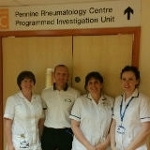
Cliff Kilgore
Consultant Nurse Intermediate Care/Older People
I was asked to see Mr A by his General Practitioner due to concerns raised by Mr A's family and to prevent hospital admission. Mr A's memory has been getting worse over the last year but he did not have a formal diagnosis of dementia.
Once a physical reason for his reduced cognition was excluded I was able to consider what I needed to do in order to ensure Mr A received the appropriate assessment and intervention for suspected dementia.
Read more on this dementia case study
With consideration to the Logic Model I referred Mr A to the local specialist memory service to consider formal diagnosis and necessary ongoing support to ensure Mr A is able to remain safe and independent. I also recorded my intervention including my advice to Mr A and his family on things to consider to improve general wellbeing such as eating and drinking well and maintaining his mobility and other activities of daily living. The referral to the memory service is collated locally to consider how effective we are measured against national statistics on dementia diagnosis.
Unfortunately there are still challenges to consider for collating health advice as this would need to be manually collected from patient records. However, there is potentially an opportunity to consider how the increasing use of electronic systems can help us to collate the impact of interventions. A change to key indicators to focus on health improvement outcomes could also be helpful in the promotion of the Logic Models.
Following the Logic Model for Dementia is a sensible reminder of the important processes and potential impacts for people suspected of a Dementia. The guidance of the model not only provides a clear pathway of what the clinician should be considering but also demonstrates how clear record keeping can be used to inform on the greater impact of our interventions. Ensuring effective interventions should be every healthcare professional's goal and therefore it is crucial that we understand whether what we are doing in clinical practice has positive outcomes for patients. Models like the Logic Model for Dementia have the potential to do this.

Gill Rawlinson
Senior lecturer, School of Health Sciences, University of Central Lancashire
Within the musculoskeletal physiotherapy services at Salford Royal NHS Foundation Trust we have worked over the last year to improve the identification and recording of lifestyle risk factors and the support offered for health and lifestyle behaviour change using the ‘making every contact count’ (MECC) approach.
Within our MSK clinical assessment and treatment service (CATS), patients also receive a 15 minute pre-assessment appointment which includes health measurements, pre diabetes screening and NHS health checks where eligible. We have used the smoking, alcohol and obesity logic models alongside our clinical work to inform and guide, and most importantly move towards better recording and measurement of inputs and output , including contacts and outcomes.
Read more on the application of multiple pathways
Our new service standards require all clinicians to record alcohol use (Audit –C score), smoking status (including use of e-cigarettes) and BMI results within the electronic record for all new patients to our service, which fits with the recommendations in the new logic models. We also record delivery of brief interventions, and communicate action plans and relevant referrals to GP on discharge. Collating this information in physiotherapy is made easier as we have a fully integrated electronic patient record across the trust.
As our MSK CATS service is ‘one-stop shop’, results and action plans are forwarded to the GP via dictated letters, to help support action and long term behaviour change, but longer term follow up and measurement of impact are more difficult. However, patients identified as pre-diabetic are referred on to one of two interventions and can therefore be followed up and outcomes measured although this takes specific man power to actively follow up these cases.
The logic models provide a useful but broad, framework for measuring impact. It is important for us to agree nationally, recognised outcomes (e.g. Audit-C alcohol score) that will help us collate and compare metrics nationally.

Lucy Knott
Physiotherapy Team Leader and Rheumatology Physiotherapy Specialist, The Pennine Acute NHS Hospitals Trust
I was initially very enthusiastic about trying the impact pathways in clinical practice; however, when I looked at them more closely I was slightly underwhelmed. This was mainly aimed at the lack of guidance on how to record and collate the interventions, something that as a department, we had been eagerly anticipating.
Despite my initial reservations I took the models to the rheumatology team, which has no existing framework of raising lifestyle issues and the physiotherapy team who routinely have healthy conversations around lifestyle, to see how they could be used in practice.
Find out how impact pathways supported Lucy's work
The AHP rheumatology team (physiotherapist, occupational therapist and podiatrist) works with people who have complex long-term conditions and lifestyle factors can have a direct impact on disease activity and an individual’s ability to manage their condition. We decided to use five of the pathways; adult obesity, alcohol, physical activity, mental wellbeing and smoking. We split these between us to avoid repetition but also to challenge us in areas that we weren’t routinely covering.
As patients came in, we found that they have been useful for ‘giving us permission’ to raise issues that we might not have done before, and also for ensuring that we were collecting data that would enable us to show the impact of our service. One of the key parts of the pathways is signposting clients to community services. It became apparent that knowledge of available services was unequal between members of the team. We have addressed this by utilising the links to e-learning modules embedded within the pathways and arranging training for the team from local lifestyle services.
In physiotherapy I chose to look at the alcohol pathway because this was an area I didn’t feel as confident about raising with patients. One patient, who had an inflammatory condition, mentioned that he drank a couple of pints, a few times a week. I followed up this conversation and suggested he complete the audit C tool. He came out as at increasing risk of alcohol dependence and after discussion, I signposted him to alcohol awareness services. In the last month, I have referred three people to alcohol awareness services, a service that I have not previously utilised.
Overall the impact pathways have been a really positive addition to our work. It’s certainly not all plain sailing and you do have to do some work to ensure they fit into your setting and the services provided. The impact of using the pathways has had a far reaching effect for us:
- Identifying team training needs, utilising both e-learning modules and local lifestyle/community services
- Developing better and new relationships with community partners/services
- Facilitated the department leads in each of their public health key areas
- Creating a data collection tool for raising and recording lifestyle factors
- Exploring the current IT provision for collating the information

Ruth Crabtree
Yorkshire Ambulance Service NHS Trust
Within Yorkshire, ambulance clinicians are able to refer patients with potential alcohol misuse problems to specialist alcohol services 24 hours a day, 7 days a week, enabling access and support to appropriate care for those most in need, at the time they need it.
Read more on this alcohol case study
This pathway is a prime example of the RSPH logic model for alcohol misuse in action as it ensures that Yorkshire Ambulance Service frontline clinicians are aware of the local support mechanisms available for patients enabling them to make an individual judgement as to the level of support that each patient requires.
Although Making Every Contact Count conversations are already being held by clinicians as per the logic model there is no system in place to robustly record the number and outcome of these conversations.
The trust is currently in the process of moving to an electronic system for recording episodes of patient care. The logic models created by RSPH will form a key part of this process. Each model will be analysed in order to inform the redesign of the Patient Care Record to enable frontline clinicians to record public health advice, signposting and referral more effectively.
As a result of this the trust will be able to collate information regarding the impact of brief advice across a range of public health concerns and lifestyle behaviours at both a regional and individual level. This is something that has not been possible before and will enable the trust to demonstrate the value that the urgent and emergency care sector affords the wider public health system. Using the logic models to develop systems for recording public health practice in this way will also provide a potential mechanism for individual clinicians to audit their own working practices.
